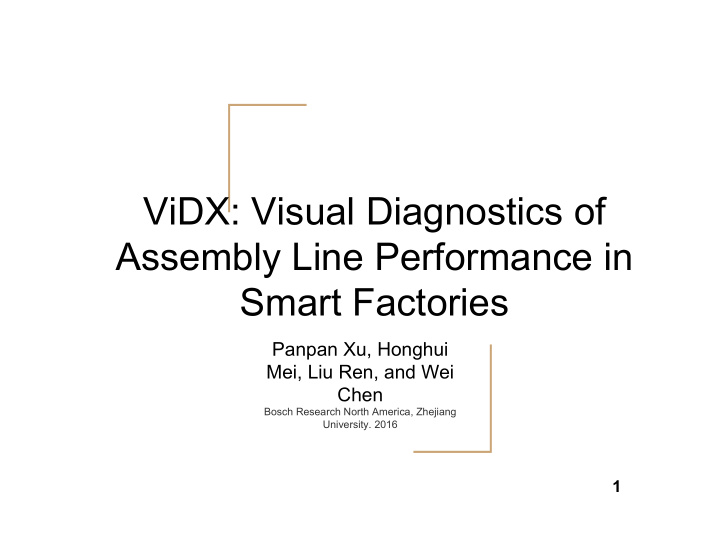



ViDX: Visual Diagnostics of Assembly Line Performance in Smart Factories Panpan Xu, Honghui Mei, Liu Ren, and Wei Chen Bosch Research North America, Zhejiang University. 2016 1
Cybersyn, Chile 1971–1973 Distributed decision support system designed by British operations scientist Stafford Beer. ● An operations room, ● Economic simulator, ● Custom software to check factory performance, ● Using national network of Cybersyn opsroom image credit Gui Bonsiepe telex. 2
SCADA: Supervisory control and data acquisition ● Industrial processes Manufacturing, Process control, power generation, fabrication. ● Infrastructure processes Oil and gas pipelines, electrical power transmission ,water treatment. ● Facility processes Monitor and control heating, http://www.promotic.eu ventilation air conditioning systems (HVAC),and energy consumption. 3
Industry 4.0 4 credit " Christoph Roser at http://www.allaboutlean.com
Every second matters! Cisco $1594 per second Samsung $1540 per second 1 year = 525,600 minute Nokia $941 per second Ford — Kansas City Assembly Plant, Claycomo, MO 460,338 cars per year Hyundai — Hyundai Motor Manufacturing Alabama, Montgomery, AL 342,162 cars per year Nissan — Nissan North America, Smyrna, TN 333,392 cars per year http://www.automobilemag.com/ 5 www.businessinsider.com/visualizing-how-much-big-tech- companies-make-2014-4
Why performance monitoring? ● TPM:Temporal productive maintenance ● OEE: Overall equipment effectiveness 6
Gantt chart Gantt charts illustrate the start and finish dates of the terminal elements and summary elements of a project. Photo courtesy: dreamfactory.com 7
Contribution of ViDX Visual exploration for : ● Troubleshooting ● Process optimization ● Decision making Identify inefficiencies and locate abnormalities in: ● Historical data. ● Realtime assembly line performance. Requirements gathered through discussion with Managers and Operators? 8
REQUIREMENTS FOR HISTORICAL DATA R1 : Facilitate the detection of abnormal processes. R2 : Inefficiencies and troubleshooting. R3 : Engaging users to detect outlier process interactively. R4 : Support predictive analysis. 9
REQUIREMENTS FOR REAL- TIME SYSTEM R5 : Highlight abnormalities in real time. R6 : Visual metaphors. R7 : Interactive exploration of large amount of process data (thousands of products everyday). R8 : Visually indicating the problematic components in 3D model!! 10 10
Assembly line as a directed acyclic graph (DAG) No error! Quality Control! How about repeating operations 11
12
Extended Marey’s graph 1885 as a visual depiction of Time train schedules. Distance b/w stations ● Train speeds, ● Dwell times, ● Directions of travel, ● Service frequency, ● Stop spacing 13
Anomaly detection 2. Halt of entire 1. Steak of efficient 3. Partial halt of assembly line process assembly line 14
Quantiles brush and Sample brush Interactive outlier detection 15
Aggregation Visualizing larger number of processes in parallel coordinates [Munzner, Tamara. Visualization analysis and design . CRC Press, 2014.pp 165] 16
System architecture and implementation 17
Case study Detect inefficiencies and troubleshooting. ● Schedule break. ● Stop and restart for a few times before operating smoothly. 18
Case study ● Several products were postponed. ● Other products have to wait. 19
Fault detection 20
Real-time monitoring Radial graph proposed by target users. Users asked for three layers of rotating concentric circles. Not effective 1. Ongoing process (light blue) 2. Length encode the time to New design finish the process 3. Fault occurs 21
Real time performance with radial graph 22
23
What: Data ● Table of workstations and product information: many value attributes. E.g Serial time values, Error and workstation’s DAG. Why: Task ● Find trends, outliers, extreme, exploration and anomaly detection. How : Encode ● Marey’s graph and parallel layouts: horizontal spatial position used to express time on each station. Vertical traces shows the products. ● Radial layout: Line length. How: Reduce ● Item aggregation. ● Filtering. Scale Dozens along vertical axis (Workstations) and thousands to millions?! polylines (products). 24
Limitations ● Data scalability: Site managers are willing to immediately know the abnormalities in each day in calendar visualization ● Longer time span in Marey’s graph: In displays with limited width, traces will become vertical lines ● Subprocess and parallel processes are overlaid Increasing the complexity of manufacturing process can cause visual clutter. 25
Suggestion User can change the distance between stations based on average process time. ● Comparing lines with different length and slope (tilt). www.toshiba.co.jp 26
Critiques v Every operation is trackable not every product. There is no jump in production line and product will be stored in case of failure. FIFO system can cause overall delay and disables abnormalities detection techniques. 27 27
Critiques The rationale behind using the radial graph is not clear!Why not rectilinear.Maybe to show the cyclic pattern!!! v Divided into same size sectors in radial graph. v The angle channel is less accurately perceived than rectilinear spatial position channel. [Munzner, Tamara. Visualization analysis and design . CRC Press, 2014.pp 166] 28
Critiques No evaluation with existing real time monitoring platform 29 29 https://www.compas.cz
Conclusion q Application of Marey’s graph in this domain was very effective. q Two anomaly detection processes were suggested for outlier detection. q System was tested with real data and they ran case studies for both historical data and real-time data. q User interviews shows promising results but no evaluation. 30 30
Future directions 1. Deployment in real production line 2. Improve scalability 3. The occurrence of outliers in composite events My suggestion: • Extend the visualization to group or uncountable products • Add indicators for sensors and their values in real time system and controllability for stations 31
Recommend
More recommend